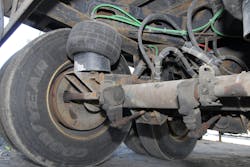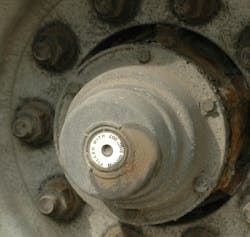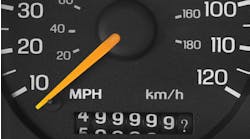Nowadays, telematics and system sensors can alert a fleet if an engine needs to be serviced or if a tire is underinflated, but there are a ton of things that can unravel on a truck that won't appear on any telematics system. Loose fasteners, fraying fan belts, leaky seals, chafed air hoses, broken springs—it's a long list. Drivers should be trained to spot such problems during visual inspections. This can help the maintenance department stay ahead of the needed repairs.
And I say this having driven for two decades—from 1978 to 1998.
Early on in my driving career, I was dispatched to pick up what turned out to be a defective tank trailer. The main (top) spring in the left-hand spring pack had broken and separated from the pack. It protruded from the back of the trailer by about a foot.
My kneecap alerted me to the problem. There was no notation on the inspection report, suggesting the driver who had previously pulled the trailer didn't notice it on his post-trip inspection.
On another occasion, I picked up a trailer with a missing landing-gear pad on the crank side. Who knows where it had parted company with the trailer? But the driver dollying down when dropping the trailer failed to notice it, or at least failed to note it on the Driver Vehicle Inspection Report.
In some of the trip inspection training I've seen—more recently than 20 years ago—illustrations of vehicle systems are usually shown intact, not in a defective state.
Presumably, an astute driver would recognize something out of the ordinary, but we can't depend on that.
For an amusing, but horrifying experience, I recommend picking up a copy of the Commercial Vehicle Safety Alliance's "North American Standard Out-of-Service Criteria" handbook, pictorial edition. There are nearly 100 pages of photos of truck parts taken during roadside Level 1 inspections. They will curl your hair.
Point drivers in the right direction
Consider adding photos of common defects—taken in your own shops—to your training library. A few should include:
- Leaky wheel seals
- Loose fasteners (with the tell-tale shiny metal under the fastener)
- Broken or cracked springs
If a driver has never seen such a defect, such a visual guide is worth a thousand words.
Tires are another source of problems. Take photos of various irregular treadwear patterns, as well as cuts and slices in the sidewalls. Drivers may be prompted to report problems they were previously unaware of by these reminders.
A look through your own maintenance records will reveal common repairs you've previously made. Note those and distribute a list to the drivers, with photos if possible, as a guide for what to watch for during inspections.
Some of the better tablet-based electronic-DVIR apps show good versus defective parts to further aid the driver in deciding if the defect is mission-critical or just something that needs attention somewhere down the line.
Is this working?
And then there are those components and systems whose little idiosyncrasies might be a little harder to detect visually.
Sludgy water draining from an air tank is an example. It's not always easy to even find the cable to drain the air tank, never mind seeing what comes from the tank when it's drained. That said, oily discharge is likely a sign of a failing air compressor. Point out to your fleet drivers where the drain cables are on the trucks and instruct them on what to look for. They may never see oily discharge, but they should know what to look for and where to look for it.
Air dryers are supposed to purge themselves regularly. If you haven’t heard that characteristic "pssssh" sound every 5 to 10 minutes or so, that could be a problem with the air dryer.
If the J-560 trailer connector plug has a short or loose wire or is just worn out, that can result in intermittent failures of the trailer lights. Often, everything goes out at once. This is usually indicative of a grounding problem or a loose plug. You should alert drivers to ensure the connector is firmly plugged in and the lights stay working at all times.
Brakes pulling left or right during a hard stop or brakes that are slow to release can be signs of a problem at the wheel-end or in a brake valve somewhere. We don't want drivers getting paranoid about their brakes, but few of them, especially the better ones, ever make hard stops. Thus, they may never feel the sensation of brake pull. Explain what it is, how it feels, and note that it should be written up for further examination.
Best help for drivers?
Years ago, an old mechanic introduced me to the best tool I ever owned, an infrared thermometer. It cut my tire and wheel-end inspection time by 90%. But better than that, I knew with some certainty that my tires, wheels, brakes, and axles were in good working order.
I'd do a tire-pressure check once a week, and every time I stopped thereafter—once everything was up to operating temperature—I’d shoot the tires, wheels, and hubs with the thermometer. The actual temperature didn't matter; I just wanted to know all the tires were roughly the same. That told me the inflation pressures were all close to equal, I didn't have a wheel-end suffering a bearing meltdown, none of my brakes were dragging, and my axles all had proper lube levels.
If one or more tires were obviously hotter or cooler than the rest, I'd get the pressure gauge out for a closer look. It was certainly a time saver, but it also provided peace of mind. That to me was worth the 10-20 bucks I spent at Amazon for a thermometer.
Unfortunately, not all drivers walking through the doors today are as mechanically inclined as some of us old-schoolers were. We shouldn't hold that against them. Rather, we should be helping understand various truck systems to the extent necessary and guiding them through mechanical inspection by showing them everything—the good, the bad, and the ugly.






